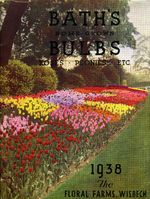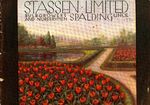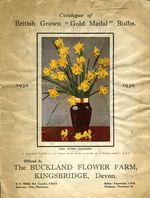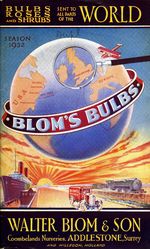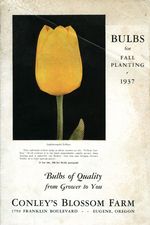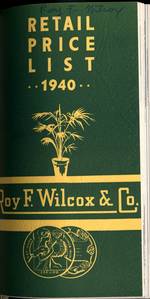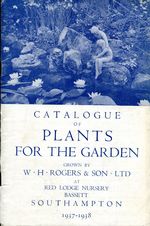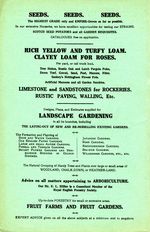“If thou of fortune be bereft
And of the store there be but left
Two loaves-sell one and with the dole
Buy Hyacinths to feed thy Soul”
Clarence Elliott List of Bulbs, Cover, 1935
The OSU collection contains seventeen boxes of catalogues from the 1930s, as well as twenty-three bound volumes of catalogues from the year 1940, organized by state—a valuable resource for researchers interested in what was available to gardeners at the outbreak of the Second World War.
Although many catalogues made no mention of the stock market crash of 1929 and the subsequent Depression, some referred to hard times and offered customers seeds, plants, and bulbs at low or reduced prices. The Burgess catalogue of 1930 contained letters from banks that testified to the company’s good credit. The Pfitzer catalogue from Germany noted in 1931 that the company cut prices for staple varieties such as cabbage, carrots, beets and onions. As the Depression deepened and international trade became more difficult, domestic industries were more heavily promoted including bulb production in Great Britain. Several British bulb catalogues from this time discuss the increasing acreage and favorable conditions for bulb-growing, and state that bulb production employed more laborers than other agricultural industries. As R.H. Bath’s bulb catalogue put it in 1938, “If encouragement is given to this industry by the bulb-buying public, it will undoubtedly result in a large increase in the employment of agricultural labour”. Even the English-language catalogues of Dutch companies noted that they employed only British labor in their production fields in England. The P. de Jager catalogue of 1939 said that it was printed on British-made paper and showed photographs of bulbs donated to English parks and schoolchildren. More bulbs were also being grown in the United States at nurseries such as Conley’s Blossom Farm in Eugene, Oregon that advertised Pacific Coast grown bulbs.
Gardening was popular during the Depression, both as a means of increasing the food supply, and as an inexpensive leisure activity. For customers who could afford them, British mail-order nurseries advertised diverse landscaping services in their catalogues, especially the planning and/or installation of borders and themed gardens. In America, the Chase Bros. catalogue of 1940 discussed how cars and good roads had decreased privacy in front yards and porches, leading gardeners to devote more resources to beautifying backyard “outdoor living rooms”, a term that first came into use in 1928.1 In contrast, front yards became less elaborate, with lawns and evergreen shrubs, and annuals or bulbs for seasonal color. Modernity was also evident in the photographs of company trucks that often accompanied landscaping ads; horses no longer appeared in catalogue photographs of the 1930s. Unwin’s 1932 catalogue discussed the difficulties of maintaining soil fertility since manure was in short supply. The company carried an organic fertilizer as a superior alternative to chemical preparations. The scans on this page show catalogues that offered landscaping services or whose catalogues contained design ideas typical of their time.


